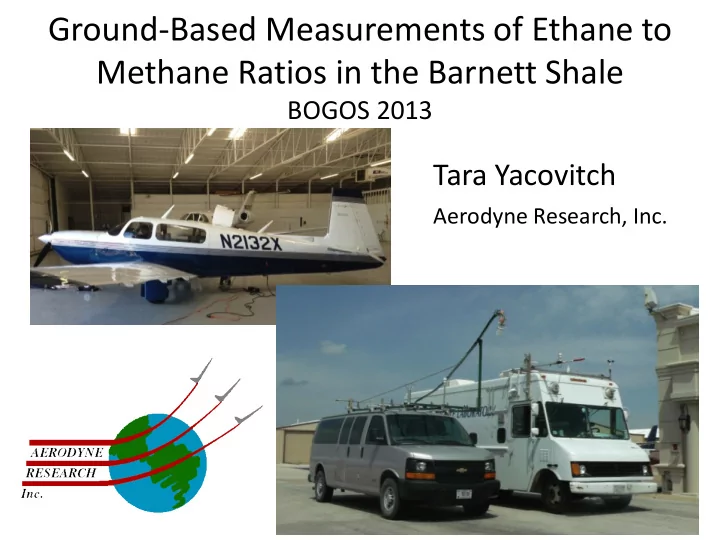

Ground-Based Measurements of Ethane to Methane Ratios in the Barnett Shale BOGOS 2013 Tara Yacovitch Aerodyne Research, Inc.
Methane and Ethane Wind from SSW 160° 5 m/s
Biogenic vs Thermogenic Methane 7%
Aerodyne’s Ethane Mini: Direct Absorption Synthetic ray-trace simulations compared to digitized spot photos of a visible trace beam further corroborate light propagation along a known path through the multipass cell A(h ν ) = linestrength(h ν ) * [concentration of absorber] length One or two football fields of length folded into absorption cell
Spectrum and Performance
Barnett Shale Play ~ 16,000 wells 2012 NG Production: 2 Trillion cf • ~ 8% of US total gas Northern Texas • production March/April 2013 Intensive campaign to quantify CH 4 emissions from oil and gas operations in the Barnett Shale NOAA, CU, UC Davis, Aerodyne, Picarro, Shell Airborne and Ground components
How to Partition the Methane? Goal: Quantify methane from oil and gas Complication: major urban centers: Dallas and Fort Worth. Landfills agricultural sources. How does one separate the wells emission contributions from various CH 4 sources? landfills
Biogenic Sources
Oil and Gas Sources
Plume Origins Bridgeport Processing Facility Producing Wells 14% South of Decatur 6% 3% More wells near Rhome
Mapped Ethane to Methane Ratios Ratio: -composition of the gas -exact emission vector (leak, tank…)
Conclusions and Future Work • Ethane is a powerful • Ground based tool for source measurements can be attribution leveraged for use in the analysis of the flight data. • Drive data reveals large scale trends and local variability in ratios
Acknowledgements • NOAA GMD: Gaby Petron, Jon Kofler, Colm Sweeney, Anna Karion, Sonja Wolter • Scientific Aviation: Steve Conley • Picarro: Chris Rella, NOAA van methane instrument • Aerodyne: Scott Herndon, Cody Floerchinger, Mark Zanhizer
BU Ethane-Methane Arts and Sciences January 2013 Building Rooftop
Are Methane and Ethane “Isotopologues” of Natural Gas? • Natural gas in pipeline is typically 97% methane and 3% ethane, hence ethane is comparable to 13 CH 4 (1.1%) • But “Isotopic abundance” of ethane varies greatly by end member: – From 2 to 10% in various gas wells (-300 to +3000 per mil!) – Fairly constant and well known in distribution systems – Very low from most biogenic sources (<0.2% or -1000 per mil) • Fractionation occurs – LNG for example
Using Standard Isotopes for Source Attribution - Left panel shows methane with biogenic origin - Right panel shows methane with thermogenic origin - But this is a hard measurement…
Using Unconventional “Isotopes” for Source Attribution Left panel shows natural gas with biogenic origin - Right panel shows natural gas with thermogenic origin - This is a very easy measurement thanks to ethane’s large variation - by source
Aircraft Results
18% 7%
Recommend
More recommend